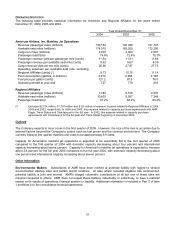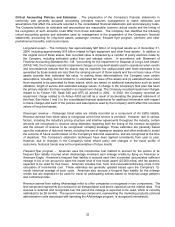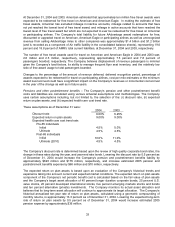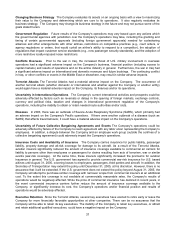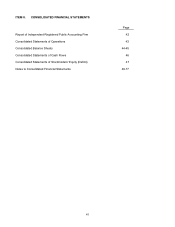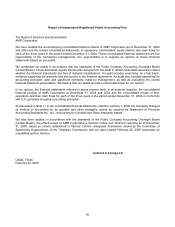American Airlines 2004 Annual Report Download - page 38
Download and view the complete annual report
Please find page 38 of the 2004 American Airlines annual report below. You can navigate through the pages in the report by either clicking on the pages listed below, or by using the keyword search tool below to find specific information within the annual report.
35
Risk Factors
The Company’s ability to become profitable and its ability to continue to fund its obligations on an ongoing basis
will depend on a number of risk factors, many of which are largely beyond the Company’s control. Among other
things, the following factors have had and/or may have a negative impact on the Company’s business and
financial results:
Economic and Other Conditions The airline industry is affected by changes in international, national, regional
and local economic, business and financial conditions, inflation, war, terrorist attacks, political instability (or the
threat thereof), consumer preferences and spending patterns, demographic trends, disruptions to the air traffic
control system, consumer perceptions of airline safety, costs of safety, security and environmental measures, and
the weather.
Substantial Indebtedness The Company has, and will continue to have, a significant amount of indebtedness.
In addition, the Company, American and their respective subsidiaries may incur substantial additional debt,
including secured debt, in the future. As discussed earlier in this Report, the Company’s substantial indebtedness
could have important consequences. For example, it could (i) limit the Company’s ability to obtain additional
financing for working capital, capital expenditures, acquisitions and general corporate purposes, or adversely
affect the terms on which such financing could be obtained; (ii) require the Company to dedicate a substantial
portion of its cash flow from operations to payments on its indebtedness, thereby reducing the funds available for
other purposes; (iii) make the Company more vulnerable to economic downturns; (iv) limit its ability to withstand
competitive pressures and reduce its flexibility in responding to changing business and economic conditions; and
(v) limit the Company’s flexibility in planning for, or reacting to, changes in its business and the industry in which it
operates.
Credit Facility Covenants American has a fully drawn $850 million Credit Facility, which consists of a $600
million Revolving Facility with a final maturity on June 17, 2009 and a $250 million Term Loan Facility with a final
maturity on December 17, 2010. The Credit Facility contains a liquidity covenant and a ratio of cash flow to fixed
charges covenant. American and AMR were in compliance with these covenants as of December 31, 2004 and
expect to be able to continue to comply with these covenants, but there are no assurances that they will be able to
do so through the expiration of the Credit Facility. Failure to comply with these covenants would result in a default
under the Credit Facility which - - if the Company did not take steps to obtain a waiver of, or otherwise mitigate, the
default - - could result in a default under a significant amount of the Company’s other debt.
Fuel Prices / Supply Due to the competitive nature of the airline industry, there can be no assurance that the
Company will be able to pass on increased fuel prices to its customers by increasing its fares. In fact, recent
history would indicate that the Company has a very limited ability to pass along the increased costs of fuel.
Likewise, increased fare competition and lower revenues may offset any potential benefit of lower fuel prices. As of
December 31, 2004, the Company had hedged approximately 15 percent of its expected first quarter 2005 fuel
requirements, and minimal amounts of its expected fuel requirements beyond March 31, 2005.
While the Company does not currently anticipate a significant reduction in fuel availability, dependency on foreign
imports of crude oil and the possibility of changes in government policy on jet fuel production, transportation and
marketing make it impossible to predict the future availability of jet fuel. In the event there is an outbreak of
hostilities or other conflicts in oil producing areas or elsewhere, there could be reductions in the production and/or
importation of crude oil and/or significant increases in the cost of fuel. If there were major reductions in the
availability of jet fuel or significant increases in its cost, or if current high prices are sustained for a significant
period of time, the Company's business would be adversely affected.








